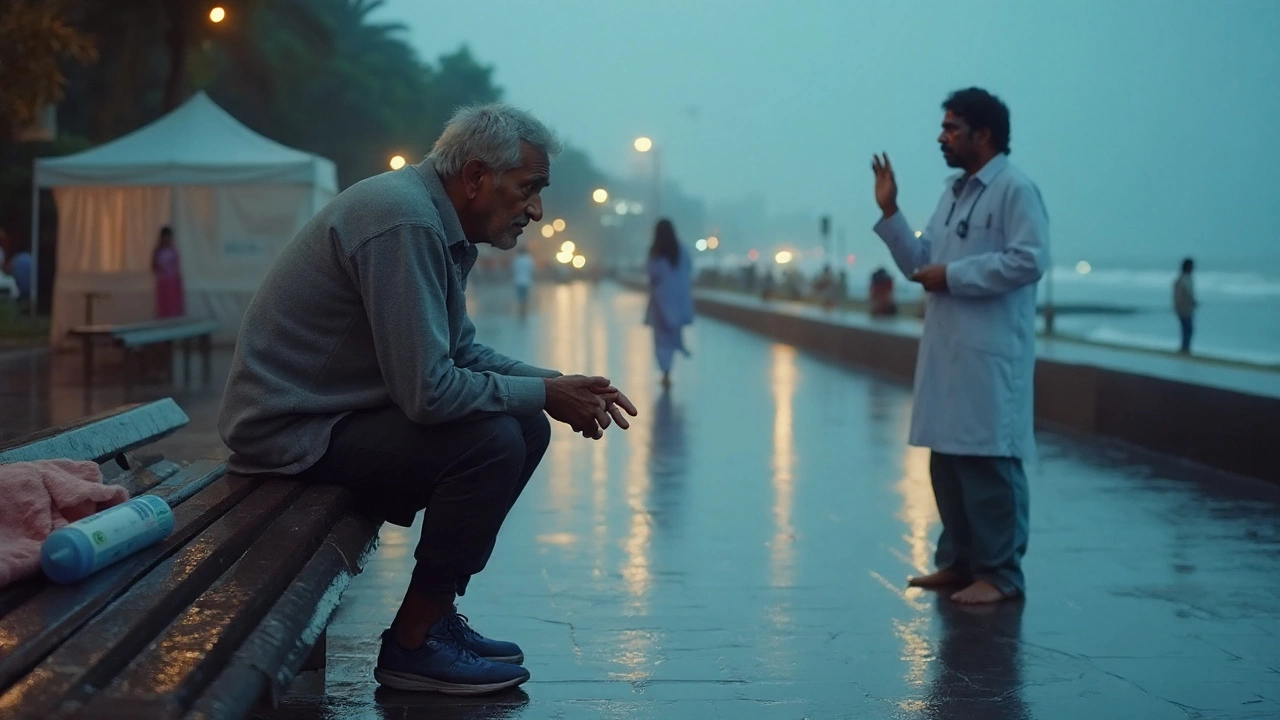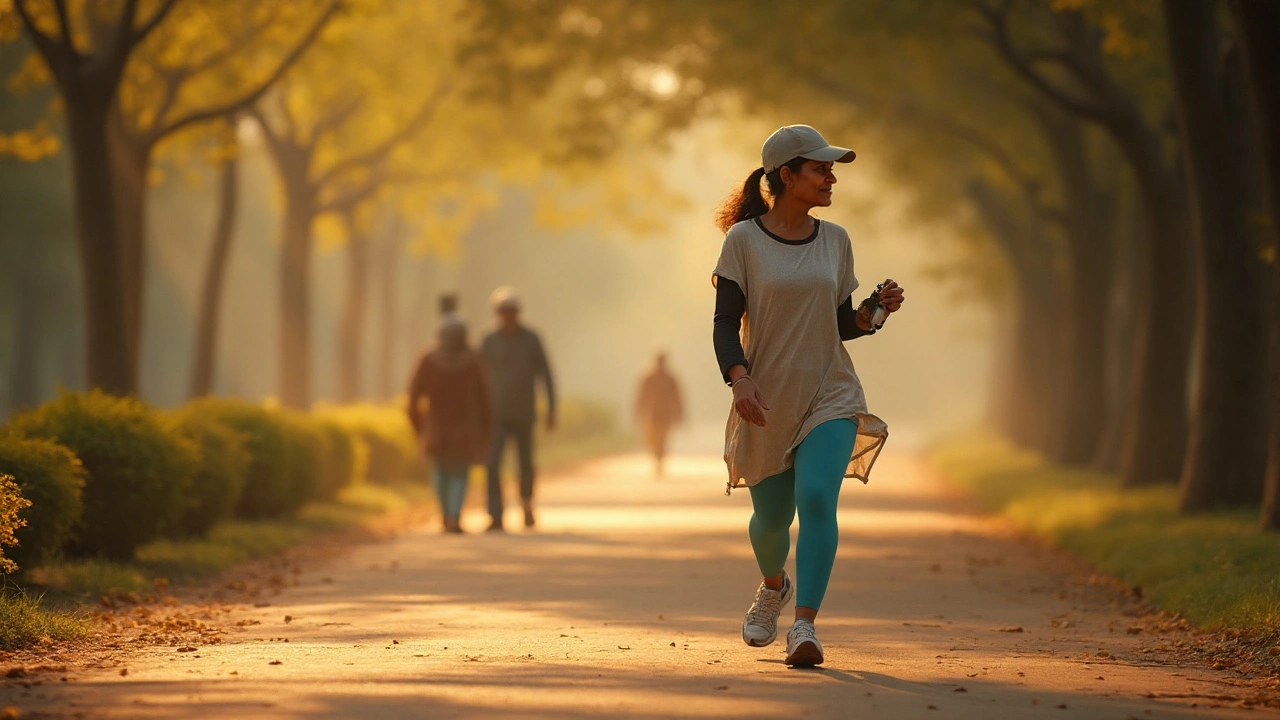Stiff knees can make even a short walk feel like a chore. The catch? Stopping movement entirely often makes stiffness worse, not better. The right kind of walking usually helps-less pain, better range, easier mornings. But there’s a line. Push too hard or walk the wrong way, and you’ll flare things up. Here’s a clear, practical plan that shows when walking is good, how to start safely, what to avoid, and when to pause and ask a pro.
TL;DR: Is walking good for stiff knees?
Yes-done right. For most people with age-related stiffness, early osteoarthritis, or desk-job tightness, walking reduces stiffness, improves function, and boosts mood. Large guidelines from the American College of Rheumatology and OARSI consistently recommend walking as a first-line activity for knee osteoarthritis because it improves pain and daily function. Cochrane reviews of land-based exercise say the same. The key is dosage and technique.
- Green light: Mild to moderate stiffness that eases as you move; no big swelling; pain stays at 0-3/10 during and settles within 24 hours.
- Use this rule: If pain climbs to 4-5/10 and lingers into the next day, cut the next walk’s volume by 25-50%.
- Start small: 10-15 minutes on flat ground, short steps, relaxed pace. Build by about 10% per week.
- Pair with simple strength work (quads, hips, calves) 2-3 days a week-the combo works better than walking alone.
- Red flags: Locking, giving way, sudden swelling, fever, or stiffness >60 minutes in the morning for weeks-pause and get checked.
What you’ll get here: a safe step-by-step plan, a 4-week progression, technique tweaks, shoe and surface tips, a quick decision guide, and a mini-FAQ. If you’re in a city like Bangalore where heat, rain, and traffic matter, I’ll call that out too.
How to start walking safely when your knees feel stiff
Your jobs-to-be-done are simple: find out if walking is safe for you today, start without flaring pain, progress confidently, and know when to back off. Follow this flow.
Check your status (2-minute self-screen)
- Morning stiffness: If it eases within 30-45 minutes after moving around, walking usually helps. If stiffness lasts over an hour for weeks, consider inflammatory causes-see a clinician.
- Swelling: A mild sense of fullness is okay; a visibly puffy knee or sharp increase in swelling means downshift or rest.
- Pain: Use a 0-10 scale. Aim to stay at 0-3 during the walk and the next day. Short, mild twinges that settle quickly are fine. Pain that builds with every step is a stop sign.
Warm-up (5 minutes)
- Heat helps stiffness: a warm shower or a heat pack for 10 minutes before your walk can ease that rusty feeling.
- Prep moves: 10-15 reps each-heel slides (lying or seated), seated or standing knee extensions (gentle), ankle pumps, and two sets of 10 mini sit-to-stands. Keep it easy; this is lubrication, not workout.
Technique that spares your knee
- Shorter strides, slightly quicker cadence. Think “quicker, smaller steps.” This reduces peak loading per step. Many people feel sweet-spot comfort around 100-115 steps per minute at an easy pace.
- Neutral knee: avoid locking it straight at heel strike. Land softly with the knee slightly bent.
- Uphill vs downhill: Gentle inclines can be kinder; long downhills load the knee more. Early on, keep downhill brief.
- Arms: natural swing, relaxed shoulders. Let your hips and ankles do some work so the knee doesn’t do it all.
Surface and route
- Best early: flat parks, synthetic tracks, smooth sidewalks, or a treadmill at 0-1% incline. In Bangalore, think Cubbon Park loops or your apartment’s flat pathway.
- Be cautious with broken pavements, potholes, and steep ramps-common here during monsoon season.
Footwear and support
- Shoes: Neutral or light stability shoes with moderate cushioning. Too soft can feel unstable; too hard can feel jarring. A small heel drop (8-12 mm) often feels kind to knees.
- Insoles: If your arch collapses a lot, simple off-the-shelf supports can help alignment. Try them for 1-2 weeks before judging.
- Bracing: A light neoprene sleeve can improve warmth and feedback. Unloader braces help specific arthritis patterns but usually need a fitting.
Set the starting dose
- New or flared: 10-15 minutes, easy pace (you can talk comfortably). If you track steps, that’s 1,000-1,800 steps.
- Some base: 20 minutes, easy pace (2,000-3,000 steps).
- Frequency: 4-6 days per week beats 1-2 long days for stiffness relief.
The 10% rule (with a twist)
- Increase weekly time or distance by ~10% if pain and stiffness are calm the next day. If you feel great, 15% is okay. If unsure, just repeat the week.
- If you overshoot and flare (pain ≥4/10 that lingers 24 hours), cut your next walk by 25-50% and add more rest between sessions for 3-5 days.
Add strength (2-3 non-consecutive days/week)
- Quads: seated knee extensions (light band), wall sits (10-30 sec holds), or short-range squats to a chair.
- Hips: side-lying leg raises or banded side steps (10-15 reps each side).
- Calves: double-leg calf raises (2-3 sets of 10-15).
- Hamstrings: bridges (2-3 sets of 8-12).
A simple 4-week progression
- Week 1: 15 minutes x 5 days, easy. Optional: one 18-20 minute day if symptoms are calm.
- Week 2: 18 minutes x 5-6 days. Add 1-2 bouts of 2 minutes slightly brisker, 3 minutes easy (x2).
- Week 3: 20-22 minutes x 5-6 days. Brisk bits become 3 minutes brisk, 3 minutes easy (x2-3).
- Week 4: 24-26 minutes x 5-6 days. Keep intervals or make the whole walk steady if it feels good.
By the end of week 4, you’re often doing 3-4 km a day without a fuss. If pain stays quiet, keep nudging time or brisk segments every week or two.

Real-world routines and examples
Everyone’s schedule and knees are different. Here are three setups I see work in real life. I live in Bangalore, so I’m factoring heat, rain, and traffic.
Desk worker with 9-6 hours and morning stiffness
- AM: 5-minute heat + 5-minute warm-up, then 15-20 minutes around your block or terrace. Keep it easy; focus on short steps.
- Noon: Two 5-minute movement breaks-hallway laps or stair-free corridors. These reset stiffness from sitting.
- PM: 10 minutes easy walk after dinner if you feel creaky. Avoid late-night brisk walks on busy roads; choose your apartment complex path.
- Strength: Tue/Thu/Sat-10 minutes of wall sits, bridges, and banded side steps.
Active parent juggling school runs
- On the school drop-off: Park 500 meters away and walk in. That’s an easy 1 km round trip twice a day without “finding time.”
- Weekend: One 25-30 minute park loop at a relaxed pace. If the park has downhills, take shorter steps and don’t chase speed.
- Monsoon plan: Use a treadmill at 1% incline, or covered corridors at home, 10-15 minute blocks. Slippery tiles? Wear grippy soles.
Older adult with osteoarthritis and fear of flares
- Walk-warm-rest pattern: 8 minutes walk, 2 minutes sit, repeat once. Total 16 minutes walking with a reset in between.
- Use a light knee sleeve for comfort and confidence.
- Choose morning hours before traffic and heat go up. In Bangalore summers, aim for 6-8 am.
- If you had a flare last week, reduce today’s time by a third and skip downhills.
Weekend warrior recovering from a meniscus irritation
- Alternate days: Walk Mon/Wed/Fri/Sun. Bike or swim Tue/Thu if you want more cardio without pounding.
- Intervals: 2 minutes brisk, 3 minutes easy x 4-only if your knee stays quiet the next day.
- Add single-leg balance (hold a chair) for 30-45 seconds each leg; better control means happier knees on uneven ground.
Across all these, the pattern is the same: frequent, easy movement; short steps; progress in small bites; strength to back it up.
Checklists, cheat sheets, and quick decisions
Is today a good day to walk?
- Morning stiffness under 45 minutes.
- No sudden swelling or locking.
- Pain at rest 0-2/10; with movement stays under 3/10.
- You can do a mini squat to a chair without sharp pain.
Technique cheat sheet
- Shorter stride, slightly faster cadence.
- Soft landings, knee not locked out.
- Keep downhills short; avoid stairs early if they aggravate.
- Relax the shoulders; let arms swing naturally.
Load management rules of thumb
- 10% weekly increase if symptom-free the next day.
- Post-walk ache that settles within 24 hours? Normal. Lingering pain or swelling? Reduce next session by 25-50%.
- During-walk pain rises step by step? Stop and switch to gentle mobility and heat. Try again tomorrow, shorter.
Gear checklist
- Shoes: neutral/light stability, moderate cushioning, 8-12 mm heel drop. Replace if outsole is worn or midsole feels flat.
- Knee sleeve: optional for warmth and confidence.
- Watch or phone timer to respect intervals and total time.
- In heat: cap, light clothing, and water. In rain: grippy soles; avoid slick tiles.
Simple decision guide
- If walking reduces stiffness as you go: keep the same pace and route; add 2-3 minutes next time.
- If stiffness is unchanged: add a 5-minute warm-up and try a slightly faster but short-stride cadence for 2 minutes at a time.
- If stiffness worsens: stop for today, do heel slides and gentle quads activation, apply heat, and retry tomorrow at 50-75% of today’s time.
Evidence in plain words
- Guidelines from the American College of Rheumatology/Arthritis Foundation (2019) and OARSI (updated through 2023) recommend walking as a core strategy for knee osteoarthritis.
- Cochrane reviews of exercise for knee OA show meaningful improvements in pain and function with land-based programs, including walking.
- Studies on gait tweaks show that shorter steps at a modestly higher cadence can reduce knee joint loading without sacrificing speed.

Mini-FAQ and next steps
Does walking wear out my knees? No. In fact, regular walking is linked to lower odds of developing symptomatic knee OA in community studies, and in people who already have OA, walking programs reduce pain and improve daily function. Overuse without recovery can flare symptoms, but that’s a dosage issue, not “wearing out.”
How much should I walk? Start at 10-20 minutes most days and build. Many people do well with 150 minutes a week of moderate walking. If you’re coming from near-zero, half of that is a great win for stiffness.
Is treadmill walking okay? Yes. Use 0-1% incline and focus on shorter steps. Treadmills are great during Bangalore’s monsoon or on busy-traffic days. If belt speed makes you tense, slow it down until your stride feels natural.
Flat, uphill, or stairs? Flat is best early. A little uphill is often kinder than long downhill. Save stairs for later phases, and add them gradually if they’re a goal.
Best shoes for stiff knees? Comfort first. Look for moderate cushioning with a stable midsole and a small heel drop (8-12 mm). If you see uneven outsole wear or feel the midsole is “dead,” it’s time to replace. If your arch collapses a lot, try a simple insole.
Should I use a knee brace? A light sleeve can improve warmth and confidence. Unloader braces help some arthritis patterns but usually need professional fitting. Braces are tools, not cures.
Heat or ice? Heat before walking for stiffness; ice after if you get a noticeable ache or swelling. Ten minutes is enough for either.
What about painkillers? Paracetamol or anti-inflammatories can help short-term flares but use the lowest effective dose and check with your doctor if you have stomach, kidney, blood pressure, or heart issues.
When should I stop walking and see a doctor? If your knee locks, gives way repeatedly, swells dramatically, or if morning stiffness lasts over an hour for weeks. Also, unexplained fever, redness, or warmth needs urgent attention.
Is walking enough, or do I need strength training? Walking helps stiffness and general health. Add 2-3 short strength sessions weekly for better long-term results. Strong quads and hips share the load with the knee.
Can I lose weight by walking? Yes, especially when paired with diet changes. Even a 5-7% body weight drop can significantly reduce knee load and pain for people with osteoarthritis.
What if I have meniscus or ligament history? Start even gentler, avoid sharp turns and downhills early, and focus on balance and hip strength. Progress is still possible; be patient with volume.
Next steps (pick yours)
- If your stiffness eases as you move: lock in a 4-6 day/week habit, add 1-2 brisk intervals on two days.
- If you’re nervous about flares: keep walks short (10-15 minutes), add heat before, and strength on alternate days. Track pain next day; adjust.
- If weather or traffic gets in the way: treadmill or indoor corridors at 0-1% incline and the same rules.
- If progress stalls for 2-3 weeks: add strength (wall sits, bridges), check shoes, and consider cadence tweaks. A physiotherapist can fine-tune your gait.
One last nudge: consistency beats intensity. In my own routine around Cubbon Park, shorter daily laps with small strides keep my knees happier than one ambitious long walk. If you remember only one thing, make it this-move often, in small, kind doses. It’s the simplest way to turn stiff knees into steady legs.
Bonus tip: If your goal is to build to 30 minutes daily, try this weekly rhythm-Mon/Tue/Thu/Sat walk; Wed/Fri strength + 10-minute easy walk; Sun optional recovery stroll. You’ll rack up the minutes without poking the bear.
And if you want a phrase to anchor your technique, here it is: “Quick steps, soft landings.” That tiny cue changes how your knee feels by the end of the block. Start with that-and your plan from above-and you’re already doing walking for stiff knees the right way.
